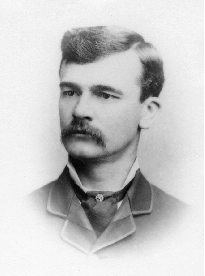

William Brigham Parkinson was born in Bradford, Yorkshire, England, on April 4, 1852, to John and Mary Woffindin Parkinson. William was their oldest child, though his parents had been married since fall of 1847. We know a few things about his parents and can guess a few others. John worked as a cordwainer (a maker of shoes and boots). Mary worked in the mills. John was close to his family his whole life. His sister Eliza joined The Church of Jesus Christ of Latter-day Saints in late 1849, followed by his sister Alice, his widowed mother Mary, and John himself in March of 1850. John’s wife Mary did not join at that time, and by the time of the 1851 census, John was living alone and Mary with her sister. Perhaps the sister was sick and Mary was helping out, perhaps John suffered a financial reverse, or perhaps John and Mary were estranged. We know that in late June John baptized Mary a member of the Church. As if to honor the event, William Brigham, their first child, was born on April 4, 1852, just over nine months later. No doubt the middle name was in honor of Brigham Young. Though the family was new to the Church, William was born a third-generation Mormon.
In December of that year, William’s grandmother and Aunt Eliza left for America. They sailed on the Mary Ellen with 332 Latter-day Saints and joined the pioneer company of Cyrus H. Wheelock, arriving in Great Salt Lake City in October 1853. Eliza married Richard Hodgson, a fellow member of the Bradford Branch, apparently on the trail. William’s father came next, sailing in late November 1855 with a group of 349 Saints on the Emerald Isle and establishing himself in St. Louis. William came to America with his mother and Aunt Alice nearly a year later on the Tuscarora (not a Church ship), leaving August 3, 1856, and arriving in Philadelphia September 27. William was four years old now. John and Mary had one child in America, Mary Woffindin Parkinson, who was born and died in St. Louis in 1857, we don’t know the dates. William’s mother died December 18 of the same year.
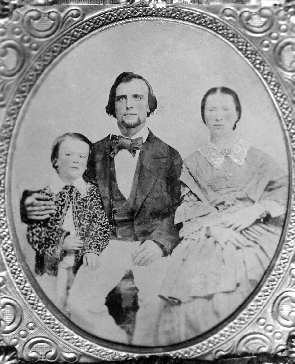 |
| William with his father, John Parkinson. The woman is probably his stepmother, Mary Ann Nutman, but may be his mother, Mary Woffindin. |
Around 1859 John married Mary Ann Nutman, a young Church member who had emigrated to St. Louis from Norfolk, England. John advertised himself in 1860 as a carpenter and bellows maker, which no doubt grew out of his experience working leather. A couple of histories say John was an architect, and it’s possible he was branching out in that direction. The Parkinsons lived in separate quarters in the same house as William’s Aunt Alice, her husband John Cameron, and their family. John Cameron worked as a plasterer or “whitener.” Both John Parkinson and John Cameron list their home address as their place of business, so maybe they were building houses together. Also nearby lived Mary Ann’s sister Elizabeth and her husband Alex Graham. John Parkinson and Alex Graham were active as ward teachers in the St. Louis branch, and John Cameron was a counselor in the branch presidency. Another story we don’t quite know: In May 1859 the Parkinsons and Grahams made a trip across the river to Illinois, where John Cameron rebaptized them. When William turned eight in 1860, it was John Cameron who baptized him as well.1
John and Mary Ann’s first child together was Eliza A. Elizabeth Parkinson, born about April 1860 in St. Louis. She may have been named for her pair of aunts, Eliza P. Hodgson and Elizabeth Nutman Graham, and maybe a third if the “A” is for Alice P. Cameron. Most the Saints considered St. Louis a stop-over, a place to get acclimated and earn enough money for the voyage to Utah. The Camerons made the pioneer trip in 1861 and were sent to settle, first Round Valley south of Bear Lake, then Randolph. The Grahams went in about 1862 and were sent to Deseret in Millard County. Meanwhile the Hodgsons moved from Utah to Oregon, perhaps to try their luck in the gold fields. John and Mary Ann decided to follow them there. Brigham Young used to urge the people not to go to the gold fields, and many who went drifted away from the Church. Maybe John and Mary Ann thought they could put together a nest egg before coming along to Zion.2 John and Mary Ann’s second child, John T. Parkinson, was born in Omaha on February 14, 1862. That summer they continued as part of a wagon train to Oregon, traveling by ox team. William, ten now, would likely have drawn the task of walking alongside the oxen to guide them. Dr. Charles R. Grant was a member of the company. Dr. Grant had lived in St. Louis and knew Alex Graham there (perhaps the Parkinsons too). Dr. Grant’s wife had tuberculosis, and he thought the change of climate in Oregon would do her good.3 John grew ill on the trip, and Dr. Grant looked after him, while Mary Ann helped nurse Mrs. Grant along. John grew worse and died October 7, 1862, and was buried on Willow Creek in Malheur County, Eastern Oregon, near where Vale is now. (Malheur means misfortune.) When they buried him they took the endboard of his wagon and carved his name on it to mark the spot, but it’s lost now.
Maud Alexander, a descendant of Mary Ann, writes: “Mrs. Parkinson was alone with three children, a wagon, an ox team and a twenty dollar gold piece. She began at once to wash, mend and bake for the miners” in the gold-rush town of Auburn, Baker County. This was a hard life, but since there were few women in the vicinity, there was plenty of work for her. The miners were so glad for womanly help that they got together and built her a cabin. Dr. Grant’s wife died in late May 1863, and on November 7 of that year he and Mary Ann were married. In 1864 they moved to Baker, Oregon, where Charles had a drugstore. Perhaps William got his first notions of doctoring from his stepfather. Charles and Mary Ann had two children, Charles J. (b. Jun. 1864) and Mary Isophene (21 Nov. 1865). William’s sister Eliza, age five, died in October of that year and was buried in Auburn.
William’s histories record that he “suffered abuse at the hands of [his] stepmother. . . . He said she was very stern and harsh with him.” No doubt Mary Ann was finding it hard to deal with the pressures she was under. (We’re not sure of the timing—this may have been a little before Mary Ann’s remarriage.) Maud, writing from Mary Ann’s perspective, says that when “Mrs. Parkinson’s stepson William became more than she could control,” two kindly neighbors, Tommie and Tammie Smith, “offered to adopt the boy, and the offer was gratefully accepted by the already overburdened stepmother. The plan, however, was not acceptable to William. He was born in England of Mormon parents and his greatest hope was to reach the city of his dreams, Salt Lake City. William Brigham Parkinson slipped away one morning when his stepmother was busy, and persuaded the driver of some mule team freighters to let him come with them.” Lorna England Bingham, a granddaughter, says William was 12 when he ran away, which would have been in 1864 or ’65.
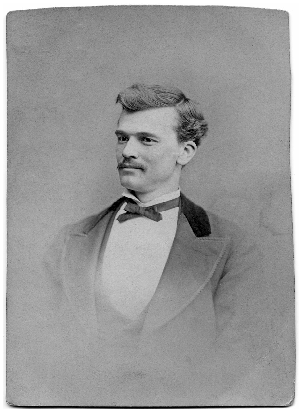 |
| William at age 27 (1879) |
Lorna says when William left it was “to find his Aunt, a Mrs. Graham, that he had heard lived in Utah.”4 This would have been Elizabeth, his stepmother’s sister, not his father’s, suggesting how close this group of family and friends in St. Louis had been. If William had managed to reach her, he would have found her in difficult circumstances: between 1864–66, the crops in the town of Deseret failed three years in a row.5 Alex had worked for Dr. Grant in St. Louis, and the doctor liked him enough that he offered to pay his and his family’s way to Baker City on the stage so he could work for him. When they arrived in Oregon, on November 8, 1863, they found Mary Ann in the doorway “dressed in black and with tears in her eyes.” Dr. Grant had died the day before. The Grahams remained in Oregon about five years, but “felt that they had gotten too far away from the body of the Church,” so they saved their money and returned to Utah. Mary Ann remained in Baker and apparently raised her children out of the Church. (The Hodgsons moved to California some time before 1868—they also raised their children away from the Church. The Utah Parkinsons have had just occasional contact with the descendants of these two families in Oregon and California. Judging from those contacts, they are good people, members of other denominations.)
William did not make it right off to Utah, but to Helena, Montana, another mining town, where he found John Chapman, a friend of his father’s. Mr. Chapman took William in, educated him, and by some accounts adopted him. According to the story, when Mr. Chapman died, he left a large estate, and William would have been entitled to his share but did not want to fight for it. We haven’t been able to learn if this was while William was living with the family or later. It was probably during this period that William worked in the mines, as one of the histories recalls, “driving burros and doing other such tasks.”6 In 1867 he went to Wyoming and worked for a rancher named Brossard, then spent some time in Idaho with a Mrs. Shultz, another friend. Finally, in 1868, at the age of 16, he arrived in Utah, where he lived and worked on the farm of Daniel Berry Bull in Morgan.
Daniel Bull was a blacksmith and did a lot of business for Indians passing up and down Weber Canyon. Lorna says that William “enjoyed talking to the Indians and learned their language well enough that he could converse with them.” She says, “William was very energetic and when the farm work was finished each day, he would study telegraphy, Pitman shorthand, and photography.” In 1869 the transcontinental railroad was completed in Utah, and William went to work at the Union Pacific station in Morgan as night operator and train dispatcher. On September 8, 1873, at the age of 21, William married Elizabeth Bull in the Endowment House in Salt Lake City. Elizabeth (b. 15 Jan. 1853 in Salt Lake City) was a daughter of Daniel Berry Bull and Elizabeth Tantam. William and Elizabeth’s first child was born in Morgan the next May.7 Six weeks later, he took wife and baby to Granger, Wyoming, where he worked as a telegraph operator and lived in the railroad station. Telegraph operators were often young and poorly paid and worked difficult hours. Before long William moved his family back to Morgan, where he worked in the co-op store. It may have been during this period that he served as president of the ward Young Men’s Mutual Improvement Association (the Church’s Young Men program).8
A year and a half after his first marriage, William married Clarissa Taggart on December 6, 1875, in the Endowment House. Clarissa (b. 12 Dec. 1857 in Salt Lake City) came from Richville, near Morgan, and was a daughter of George Washington Taggart, a carpenter and millwright, and Clarissa Marina Rogers. Typically a man entering plural marriage had been married to his first wife for ten years or so and had established himself in a career. Taking on the support of two wives at such a young age probably says something about William’s drive. Over the next three years in Morgan, Lizzie and Clarissa each had two children.9 William was called to serve a mission in England, beginning in May 1879. He was 27 when he left. Missionaries in those days were generally supported by the local members and investigators in the places they served. By one account Lizzie and Clarissa lived in a house together, while according to another each went to live with her father while William was gone. Lizzie had a daughter a few months after William’s departure, her fourth child and William’s sixth.
 |
| William during his mission to England, 1879–80 |
We know from a pair of letters in the Millennial Star that William served in Sheffield, Derbyshire, and the Leeds conference. He visited Bradford, the town of his birth, in May 1879, where his relatives urged him to stay a month. He could only stay a few days then, but that fall he was stationed in Bradford. Lorna notes that during his mission William gathered “a record of the families of his people. We do not know whether he converted any of them but later on in his life, he did the temple work for them.” William writes of his activities for the month of July 1879 as follows:
“We held fourteen out-door meetings last month. The weather was so bad we could not hold any more. At all of these we received good hearing, and but very little opposition. On one occasion, at Whittington Moor, two men came to oppose us, but our hearers would not let them speak. They had quite a row among themselves, after which Brother Emery induced them to go with us to Brother Yates’s house, and show us where we were in error; but I think they left us much wiser men. They have never tried to oppose us since. The Saints turn out well at our out-door meetings, enabling us to have good singing, which generally brings us an audience.
“We have baptized some few into the Church, but we realize that to-day is the ‘gleaning after the vintage is done.’ We are blest of the Lord in our speaking. Many believe our message, but few have the heart to embrace it and leave the old and venerated, long-established faiths of their fathers. With the help of the Almighty we try to speak plainly and pointedly, following [the president’s] instructions, when bearing our testimonies, by showing them the position they are in after hearing the Gospel preached; that it leaves it with them and their Maker, clearing our skirts from their blood, so that when we meet at the bar of God, they will have to give an account for not having received our testimonies.”
According to Lorna, William “stayed on his mission about a year and a half till 1880. He was released on account of suffering so much with rheumatism” in his shoulder. While William was on the return voyage, Clarissa’s children were struck with scarlet fever. Albert died October 4 and Clarissa Atelia the next day, October 5, which left her with no children. William arrived home the day after she buried them. They had another child born next summer.
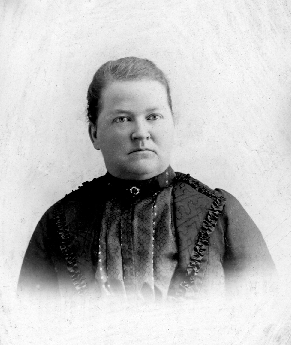 |
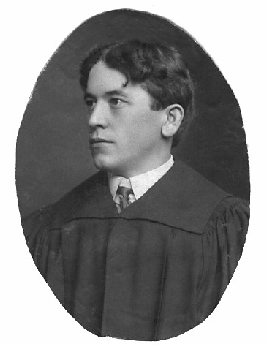 |
| Elizabeth Bull Parkinson | William B. Parkinson Jr. (Billy) |
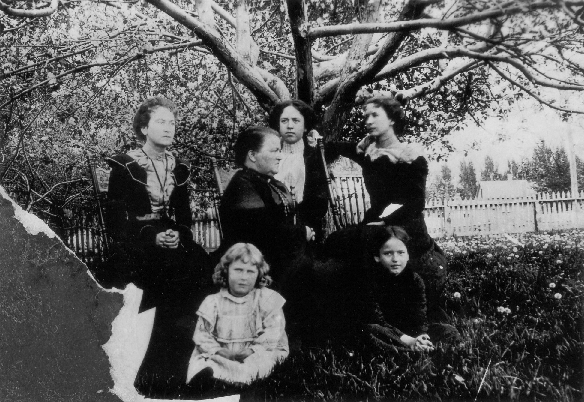 |
|
| Elizabeth with her daughters: Lizzie, Ada, Lilian, Afton, and Winifred, about 1895 |
|
The next spring, on May 15, 1881, William, age 29, was made a high priest and called to be bishop of the North Morgan Ward. Meanwhile, in 1879, Dr. Frederick S. Kohler had moved from Ohio and established a practice in Morgan. Mormons in earlier times were often mistrustful of doctors. In those days doctors were often self-taught and tended to rely on emetics and purgatives and in many cases probably did as much harm as good. Dr. Kohler was a new breed of doctor trained in the science of medicine in eastern schools. The Church encouraged this kind. Dr. Kohler, not a member of the Church, liked the locale and the people, and the people liked him. Getting enough doctors of any kind in Utah was always a problem. Dr. Kohler, with the backing of local Church leaders, attacked the problem by launching the “Medical College of Utah” in Morgan in 1880. William, who was always trying to better himself, enrolled. The college operated for two years. One of its graduates was Emeline Rich, who had served as a midwife and healer in the Bear Lake country for years. In summer 1882 the Salt Lake Daily Herald got ahold of some of the college’s advertising and began to attack it as a diploma mill. William wrote a letter to the editor in its defense, which the Herald ran on the front page:
“I must truly say I am surprised at the ignorance manifested on your part in relation to the existence of this institution. If you really were in ignorance about this matter, why did you not apply to the resident, secretary, or any of the trustees, who by the way are all bone fide residents, and honorable men in our community, or the matriculants, for information, which would have been given with pleasure? You can rest perfectly at ease. This institution is gotten up for the purpose of educating our people in the profession, thereby preventing so much cutting and quacking as heretofore existed in our country. Dr. F. S. Kohler, the dean, is an old army surgeon and graduate from one of the best schools in the United Sates. . . . The college is properly organized, and no diplomas will be issued to persons unless thoroughly competent to practice medicine in all its branches. . . . As to the genuineness of the institution I can testify as a student to its beneficial effects.” (30 Jul. 1882, p. 1)
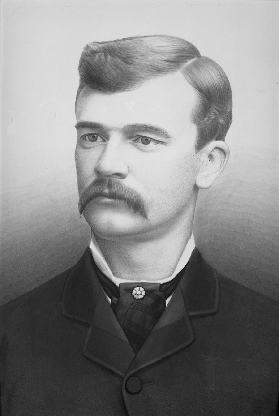 |
| William sometime after 1886 |
The Herald replied in an editorial in the same issue: “Bishop W. B. Parkinson, of North Morgan Ward, is given space in this morning’s Herald to say some good things about Dr. Kohler and his ‘Medical College of Utah,’ and also to exhibit his want of manners, which latter he does in the coarse and ungentlemanly tone of his communication.” The Herald found it incredible that a medical college would have been operating in such an out-of-the-way spot without any of the Salt Lake doctors they asked knowing anything about it. The editorial continues:
“Bishop Parkinson knows what he is about when he lends his official church endorsement to such an institution as the ‘medical college of Utah’ which he must know if he knows anything, is altogether irregular and bears on its face the evidence of crookedness or that the founder is next door to an idiot. . . . We have been expecting some such letter as Bishop Parkinson has written, but did not look for it to come from a bishop, with his full title set out to add to its authoritative character; and layman as the Herald is it makes bold to suggest that the bishop has blundered this time if never before” (p. 4).
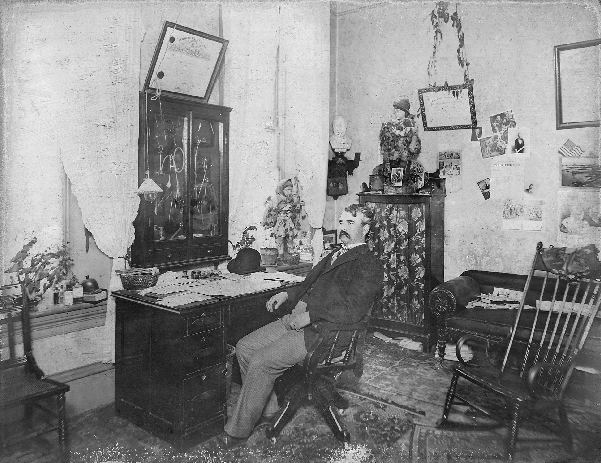 |
| William in his office in Logan |
Robert T. Divett, a medical librarian who has written on the history of the college, says he believes the school was legitimate. He notes that the textbooks used were current, the same ones used in the best schools in the country, and that the course work was supplemented by twice-weekly clinics, an advanced idea for the time. But as William learned, the man with the most ink and paper often gets the last word in an argument. The Herald continued its crusade, and the school failed to open for its next regular session in August of that year.
William continued as bishop in North Morgan until 1883, when he resigned to attend Rush Medical College in Chicago. Elizabeth and Clarissa and their children moved in together. One wife would watch the children while the other made rugs to sell.10 Hazel, a daughter, says: “My mother [Clarissa] and the first wife Elizabeth lived together for 8 years and never had any disagreements. (They must have been angels.)” Maud Alexander says William was educated at the Church’s expense, which is possible—the Church helped other doctors with their education in those days. After matriculating, William returned and practiced for a time in Coalville and Farmington. In 1885 he moved his families to Logan. About that time he hired an 18-year-old girl named Edith Benson to help out in his two homes. Edith (b. 22 Apr. 1867 in Logan) was a daughter of the Apostle Ezra T. Benson, who died in 1869 when Edith was just two years old, and Elizabeth Gollaher. We know nothing of William and Edith’s courtship, only that they were married in the Logan Temple on January 27, 1886.11
In this period federal marshals were active in the territory, and though the Saints felt plural marriage was a religious practice protected by the U.S. Constitution, many Mormon men were sent to prison for living the principle. William avoided arrest by keeping on the move. The years 1886–88 he spent in Oregon, taking his new wife Edith with him. This gave them a sort of honeymoon as they began their family. Maud Alexander records that he visited his stepmother in Auburn. After Dr. Grant died, Mary Ann had gone back to washing, mending, and cooking to support her children. On December 13, 1871, she married David S. Littlefield, one of the area’s first miners, and things finally began to look up for her. The mines played out, but David and Mary Ann filed on a tract of good land, built a spacious house, and began to raise horses for sale in the East. They had three children: Rufus W. (born 21 Sep. 1872), Eva Loretta (2 Feb. 1874), and Grace (15 Jun. 1877), which made a total of seven for Mary Ann. William settled in Pilot Rock, farther north in Oregon, where he practiced medicine. He and Edith had their first two children there.12 In 1887 he completed a post graduate degree at the Medical School of Chicago. In 1888 William and Edith returned from Oregon to Cache Valley, where William took a fourth wife, Margaret Wallace Sloan, we think in September 1890.13 Margaret, born April 12, 1862, in Liverpool, was the daughter of prominent newspaper editor Edward Lennox Sloan and his wife Mary Wallace.14 William and Edith’s daughter Karma says that during this period William rotated between his families, spending a week with each. In 1890 William completed a course at the New York Post Graduate Medical School. In 1892 he traveled to Louisville, Kentucky, and completed an M.D. degree.
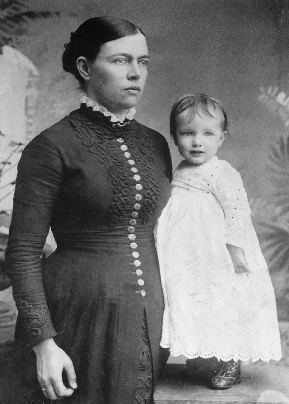 |
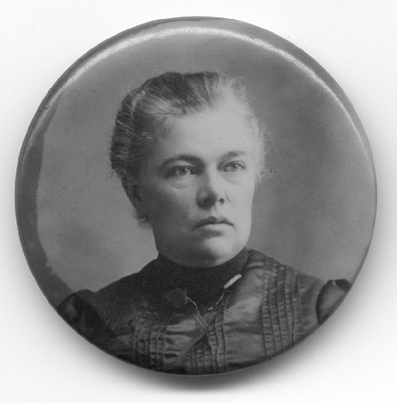 |
| Clarissa Taggart Parkinson and daughter Hazel, about 1891 |
Clarissa about 1900, from a broach |
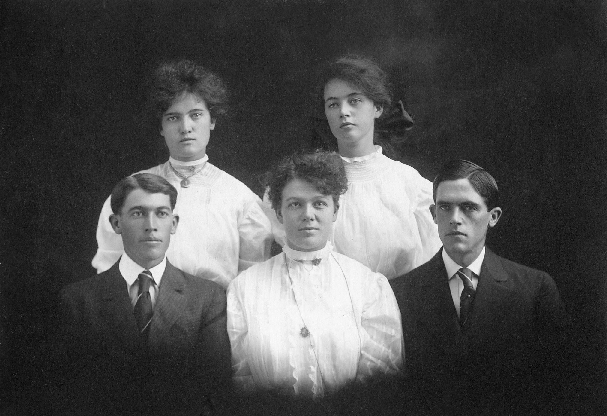 |
|
| Clarissa’s children: Leona, George, Marcus, Hazel, and Alice | |
William practiced in Logan with a Dr. Ormsby but after a few months branched out on his own. He had a second story office on the corner of Main and Center and later farther up on Main. Karma says of the first office, “I used to like to go down and watch the circus parades because I could get such a good view from these big windows that were there.” William had the first X-ray machine in Logan, quite a large contraption, and a big room with a bed in the back of his office where he performed surgery. He would make rounds all over Cache Valley in his buggy. Karma, who as a girl sometimes rode along with him, remembers his old reliable horse Jeff. Once Jeff thought William was taking too long at a patient’s, so he went ahead and pulled the buggy to the next house without him, waited awhile, and so on to all the others, stopping for a time at each one before going home. Later William bought one of the first cars in the valley. Karma remembers: “He had a Ford that had to be cranked by hand. There was an iron wrench the boys would push into a socket and turn around right quick and that would start the engine. It was a great day when the self starter was put in cars and all we had to do was step on it. The men used to turn the crank sometimes until they were exhausted before it would start.” When she was older, Karma learned to drive and took him on his rounds.
Karma says her father was dedicated to his patients:
“We had two telephone systems here at that time, one the Bell system and the other a local one, so father installed two telephones. He had our house wired so at night he would unplug the two phones that were downstairs. I can see him now when it was bedtime gathering up his two telephones and carrying them upstairs where he slept. He would plug in the phones, place them on a little stand by his bed so he could answer them in the night and maybe phone in a prescription to the drugstore or tell the patient what to do, or if necessary he would get up, hook the old horse to the buggy (or later crank up the old car) and go out in the night to take care of his sick patient.”
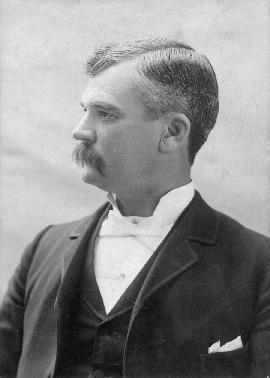 |
She continues: “There was another group of doctors in Logan that weren’t too friendly with him. He didn’t like the way they practiced so he . . . had an old home that he made into a hospital.” She notes, “He maintained that for years.” He trained his wife Elizabeth to be a nurse, and most his daughters worked for him at different times, either as nurses or office girls, admitting patients, helping clean up after operations, and so forth. Karma tells of a time she went with him to deliver a baby. “When the baby was born he handed it to me and told me to take some oil and clean it off and dress it while he took care of the mother. I don’t know what kind of job I did but I felt quite helpless.” He told her afterwards that this was the ninth child he had delivered for this woman and had never been paid for any of them. Lorna reports that “he did much charity work never refusing to take a case because the fee was not forthcoming.”
Karma says: “I can remember the talks he used to give in church. He hated alcohol and he would give talks about the Word of Wisdom.” One of his lectures, delivered before a “parents’ class” in Logan, was published in the Church’s magazine, the Improvement Era, in January 1915 (p. 221). In it he discusses the chemistry of fermentation, calling alcohol “the death principle of all decayed vegetable or animal matter, found nowhere in living, growing nature, but everywhere in dying and dead matter.” He notes that “it has been demonstrated beyond all controversy that the children of parents begotten while under the influence of liquor are below par, intellectually.” He groups alcohol with cocaine and morphine, asserts it had no value as a medicine, beyond its use as a solvent in the preparation of certain medicines, and gives evidence that alcohol does not aid but impedes digestion. He quotes an authority to the effect that the lower organs of the body and brain, because of their proximity to major arteries, are most affected by alcohol, and expands on the theme:
“The organ of acquisition or desire to get, possess, and accumulate is . . . one of the lower organs of the brain, we all know how common it is for drinkers to be found with a mania to steal, or rob, gamble or lie; hence the enormous, outrageous lies the tipsy man will tell, and then gloat over the enormity of their falsehoods.
“Again, the organ of amativeness or sexual love is one of the lower organs, through which pass some of the larger arteries, and when filled with poisoned blood, the person will be possessed with a mania for lust. Young men go from the saloon to the house of prostitution. Husbands drinking this poison are apt to prove faithless to their marriage vows. Wives who drink to intoxication want only opportunity to commit adultery.
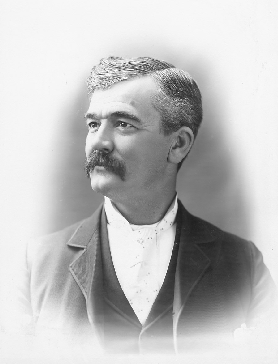 |
“I have been in the active practice of medicine for the past thirty-two years, and can testify that ninety per cent of all the cases of venereal disease I have treated became infected while under the influence of this poison alcohol. On account of the lower organs being so unduly excited and the higher organs of reason, judgment, conscience, and will, not being equally excited, so as to control them, the man ceases to be himself, and is directed and impelled by his lower organs and passions, and becomes obedient only to the powers and forces of evil.”
He continues:
“There comes a time in the history of the drunkard when he no longer sings, is witty, desires to be lustful, lie, steal, or beat his wife or children. The organ of caution becomes inflamed, and he becomes cautious, and fearful; he sees strange things, and trembles with terror. The nerves of the eyes become inflamed, and he sees awful sights, wild animals, fierce beasts, slimy serpents, huge, terrible and hideous. The nerves of the ear become inflamed and he hears strange and awful noises, the growling of monsters and the laughing of fiends. The nerves of the nose become inflamed and he smells terrible stenches. The nerves of feeling become inflamed and he feels the points of sharp daggers, hot coals, and blazes of burning ruins. . . . Anguish and hopeless remorse take possession of his soul, and while he is raving and calling for protection against these evils, the vital organs, scorched and burned with the alcohol, cease to perform their duties, and in many cases the victim dies a horrible death (delirium tremens).”
Karma says all during her childhood (turn of the century) William continued to travel to the East to brush up on his profession. She says, “He was really loved by a lot of people that he took care of. His patients were always bringing him fish and things that he liked . . . to show their appreciation.”
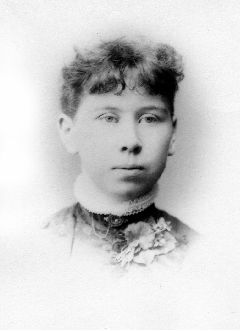 |
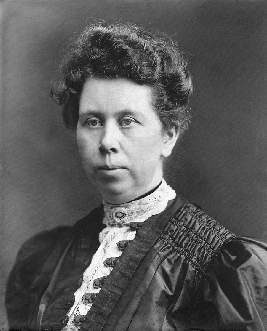 |
| Edith Benson Parkinson, possibly 1886 |
Edith a little older |
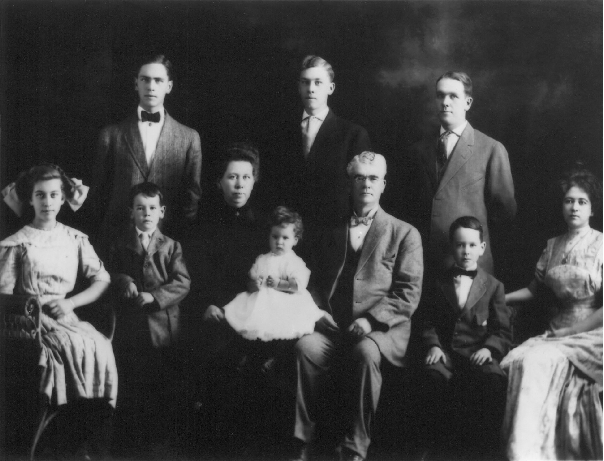 |
|
| Edith’s family. Back, L-R: Ezra (Ben), John (Jack), Fred. Front: Karma, Don, Edith (mother), Edith (baby), William, Wallace, Veda |
|
On October 6, 1890, Church President Wilford Woodruff issued the Manifesto, which declared that the Church would sanction no more plural marriages. If the family record is correct, this was just weeks after William’s marriage to Margaret. Six months later, Elizabeth bore her last child, which gave her and William six in total. William still found it necessary to keep a low profile. About this time he moved his second and third families to Franklin, Idaho, and ran the town’s first drugstore. Clarissa’s last child was born here nearly a year after the Manifesto, giving her and William a total of seven, five of whom lived. William and Margaret’s marriage appears to have been a civil one at first. Clara R. Ward, a granddaughter, says: “I was told that she was the only one [of the wives] that was married according to the laws of the land.” This would have put Margaret in a difficult situation, living in polygamy with its stigma in the eyes of the world, but without the Church’s sanction either. Clara says, “Mother told me once that Uncle Ed and Uncle Bob [Sloan] threatened to horsewhip Grandfather if he didn’t have my Grandmother sealed to him.” The only way that could happen now was if he divorced Elizabeth. Perhaps husband and wives discussed it and agreed—we don’t know. Court records show only that in July 1892 William filed for divorce. As near as we can tell, Elizabeth did not contest it, and the divorce was granted August 23. Eight days later, on September 1, 1892, William was sealed to Margaret in the Manti Temple.15 William appears never to have lived with Elizabeth again, though he supported and visited her. Likewise he visited Clarissa but had no more children with her. With Edith he had two more children, one eight months after he was sealed to Margaret and one four years later. William and Margaret had three children.16
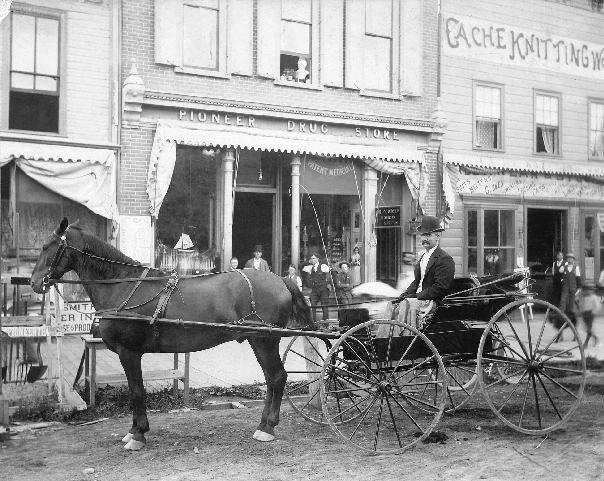 |
| William and his old horse Jeff in front of his office on Main Street in Logan, 1912 |
Karma, who was the younger of Edith’s children born during this period, remembers family life as harmonious. Each wife had her own house. Karma as a girl liked to visit Elizabeth, who would give her apples from her trees. The children called the other wives Aunt. “I remember well that Father would have a pork slaughtered and have a butcher come into our house and cut it up. He would send half of it to Aunt Lizzie.” Karma visited Aunt Margaret too, whose daughter Louisa was close to her in age. Margaret kept her yard lush with peonies, which Karma loved. She remembers Margaret was not well much of the time. Of Aunt Clarissa she says: “My mother was very fond of her. My mother often told me how they would visit together. When it was time to have dinner, they had so many children when they got them all together. . . . They used to have boilers that they would boil their clothes in when they laundered them. They would put the corn in those big things and cook it.” Karma notes that some of the grown children of the other wives would bring their families to visit Edith when they were in town. “They seemed to enjoy coming to our home as much as they did their own mothers. . . . We were always friendly with our half brothers and sisters. We were united.” Hazel, another daughter, agrees: “I am sure we were one of the happiest polygamous families in the Church. My half brothers and sisters are very dear to me.”
 |
| William had one of the first automobiles in Cache Valley. |
William’s marriage to Margaret, however, was ill-fated. Clara says that besides the three children they had stillborn twin boys. She speaks of a time when all three living children were sick. “My mother . . . got whooping cough, the red measles, and what we know now as a staff infection . . . all at the same time and before she got over that, she pulled a pan of boiling water over on her and burned herself.” Venoletta, their youngest, just eight months old, died at about this time. Margaret “was just so ill trying to take care of the children that her nerves gave out on her and apparently she was going to have a nervous breakdown and so they gave her some laudanum to sooth her nerves and calm her down. Apparently, she became addicted to it.” Judging from William’s lecture in the Improvement Era, this must have deeply troubled him. He treated her and thought he had gotten her over the cravings five separate times, but each time her addiction proved too strong.
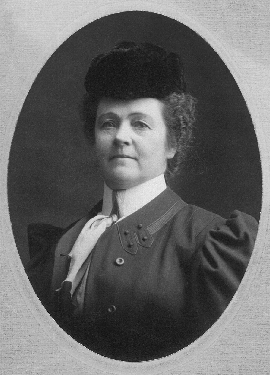 |
| Margaret Wallace Sloan Parkinson |
In November 1899, after he became convinced she had given opium to the children, he moved out and sued for divorce and custody. She countersued on the grounds that he was living in “open and notorious adultery” with “one Edith Benson” and had committed adultery with “one Clarissa Taggart, alias Clarissa Parkinson.” William could have gone to jail, depending on how he answered. It is difficult to believe Margaret hadn’t known at the outset that she was entering a polygamous marriage, and according to William, Margaret condoned the birth of Edith’s children as late as 1896. No doubt Margaret felt her back was against the wall when William sued for custody of the children. Each alleged cruelty. On January 23, 1900, Margaret’s lawyer grilled William on the stand, and the next day the anti-polygamy-crusading Salt Lake Tribune carried a scathing account on page 1. William’s lawyer felt obliged to counter the charges in the next day’s Deseret Evening News, so now these painful events were everyone’s business. As if William and Margaret didn’t have enough to deal with, in April their oldest daughter, Willa, died. The divorce dragged on until December 17, when the judge ruled in Margaret’s favor, awarding her custody of Louisa, their remaining child.
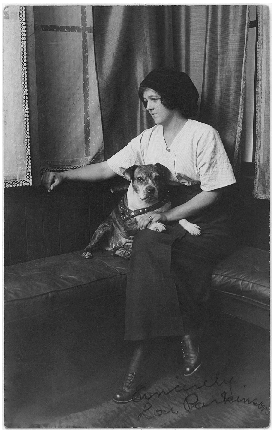 |
| Louise Sloan Parkinson in 1914 |
Karma, interviewed in 1978, gives no indication she was aware of the divorce, which may say something about the good feelings in the Parkinson family, even in the face of adversity. Some of her happy memories of visiting Margaret would have to be from after the divorce was final. Margaret took Louisa to Portland (Karma inherited Margaret’s peony bulbs). Clara says Louisa spoke of parties and rides on the riverboats, and that Margaret supported them by writing for Cosmopolitan, which at the time was a literary magazine.17 Clarissa died unexpectedly on July 15, 1903, at age 45, just a month after the divorce. Karma says William lived exclusively with Edith now. Edith took in Marcus, Clarissa’s 17-year-old son; and Clarissa’s oldest living daughter, Leone, moved into Clarissa’s house to take care of her other children who were still at home. Elizabeth lived alone with her three youngest daughters. Edith had three more children, giving her and William eight, and twenty-four total for William. The last, also named Edith, was born in 1909, 35 years after Lilian, William’s first child, was born.
Karma says William had thick, dark, wavy hair that went white by the time she was old enough to remember, so likely by the time he was 50. He was short. According to Karma, “He always said he was stunted when he was a child because he had to work so hard.” Lorna says, “He could whistle and run up his office stairs when he was 66. . . . He always said that people are as old as they feel.” Karma notes, “He didn’t talk a great deal. When he came home from the office he started reading his newspaper or some book. He was always studying”—subjects including psychology, the Spanish and Swedish languages, various scientific disciplines, and Eastern religions, as reflected in Karma’s and her sister Veda’s names. Karma doesn’t remember him having many Church callings during her childhood. “He was always busy with his work.” As noted, he did lecture on alcohol, as well as psychological subjects, to church and other groups. Lorna says he was a stump speaker for the democrats.
Karma notes: “One thing father believed was not to give his children everything they wanted and I knew later that this was a good thing. Maybe he could have afforded to give me some of the things that children have now but I didn’t ever own a bicycle and I wanted one so much. I learned to ride on an old one that our neighbors had.” On the other hand, he would take her up to the east side of town where a woman had a hothouse and would buy her flowers, and he let her charge anything she wanted by way of cloth and sewing supplies at John Anderson’s store. Some of his teenage boys began to run wild, so in 1905 William bought a farm near Cornish and sent them out to run it. Lorna says: “They did not turn out to be very good farmers, as they had no training for it, but from their reports, the children enjoyed it.” He supported his sons on missions, all who wanted to go, and paid for their educations. Of his eight sons who lived to adulthood, three became medical doctors, one an eye doctor, one a pharmacist, and one was studying to be a medical doctor when he died. Karma attended university. “Every fall after I started college father would say, ‘This will be the last year. A high school education is enough for a girl.’” But she would plead with him, and her mother Edith took her side, and before she was through she had a bachelor’s degree.
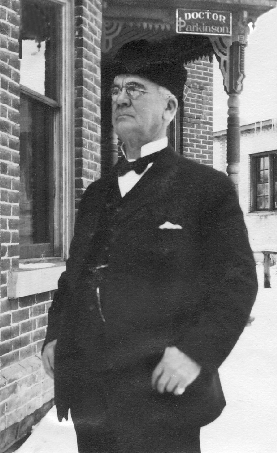 |
| William in front of Edith’s house18 |
According to Lorna, William’s “children laughingly remark how he was always trying to engineer good marriages for them.” Karma tells a different side: “Father was . . . very strict about people who courted his children coming from good stock or the right families. I was always embarrassed when a new boy came to take me out and I would introduce him to my father. He would look at him and say, ‘Who is your father,’ before even saying hello.” She was relieved when she brought home Bernice Parkinson, her future husband—William knew and respected his father and grandfather. (Karma kept her name when she married. Though Bernice’s grandfather came from Barrowford, Lancashire, near where William was born, we’ve never found a connection.) Karma continues: “Father was very determined that several of my half sisters shouldn’t marry certain boys, but as things turned out it seemed that they would have been better off and much happier if they had married the boys they fell in love with first, but gave up because of some objection that father had to them.” William’s oldest living son Billy fell in love with Carrie Jensen, a beautiful girl from a poor immigrant family who came to work in the Parkinson home. Billy’s daughter Peggy P. Benson writes that William Sr. “strenuously objected to the match.” Perhaps he thought his son was too young to marry, that it would get in the way of his education, or having risen out of poverty himself, perhaps he wanted him to marry into a socially prominent family. “Young Will was hustled off to medical school in Chicago. It must have seemed like the end of the world to Carrie. She returned to her parents’ little farm in Hyrum, Utah, where her son, William Jensen Parkinson, was born” in 1899. Billy married Evans Beth Troop, his landlady’s daughter in Chicago. Karma says her father “enjoyed delving into subjects such as psychology, palmistry, astrology and learned to read the stars and read horoscopes. I didn’t like this idea so much because some man he studied with wrote Veda’s horoscope and predicted that something awful would happen to her, so Veda wasn’t allowed to grow up normally and have boy friends (she never went out only when escorted by one of her brothers), and she was very unhappy and didn’t marry until she was too old to have children, which was a tragedy.”19 These traits—the tendency to interfere in his children’s marriage choices and the indulgence in occult subjects—were probably William’s greatest failing.
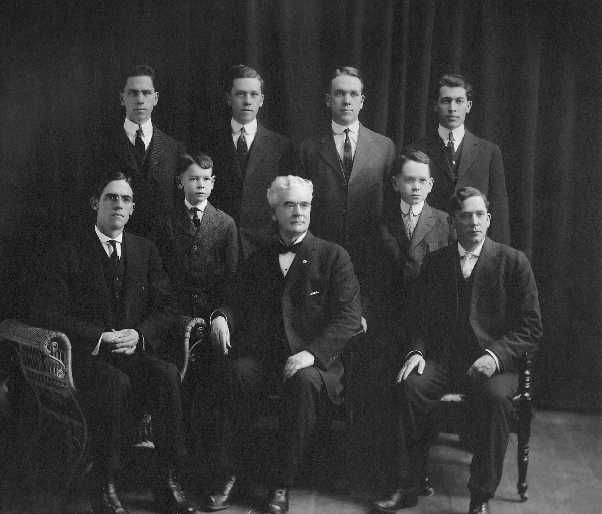 |
| William with his sons. Top, L-R: Ben, Jack, Fred, Mark. Bottom: George, Don, William Sr., Wallace, William Jr. |
But it is clear that William tried to give good care as a doctor and relieve suffering, tried to give service to the community, and tried to do his best by his family. In Karma’s account he comes across as strict but tender, sometimes to the point of indulgence. William, who saw plenty of pain and suffering in his profession, had a creed that started out: “Don’t keep your fountains of your love and tenderness sealed up until your friends are dead; fill their lives with sweetness now. Speak approving and cheering words, while their ears can hear, and while their hearts can be thrilled and made happier by them.” Karma says he lived by it, and that he had it printed on cards and gave it to his friends.20 She describes her excitement going to the station to meet him after he had been east to study, the steam of the engines and clank of the cars. He always brought them gifts, such as clothes and Horatio Alger novels. Like Ragged Dick in the books, William never stopped trying to improve himself. In 1907–8, he completed a course at the Chirurgical College of Philadelphia, Pennsylvania. With more doctors established in Logan now, he decided to specialize in diseases of the eye, ear, nose, and throat. This required course work in Berlin and Vienna. “He had to learn the German language so he could enter the post graduate school there, so he got some books and went to work. Every evening was spent studying. . . . This was a wonderful thing. He was past fifty and had a big family and he was able to master German well enough to be able to go over there and successfully complete the course he wanted.”
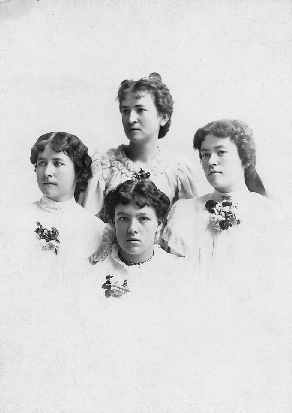 |
| Four of William’s daughters. Lilian (top), Lizzie (left), Leona (right), Ada (bottom) |
He made the trip in 1914, taking his grown daughter Elizabeth and her friend. He attended a medical convention in London before continuing on to Germany and Austria for his course, while the girls toured Italy and Switzerland, meeting him back in England. William took advantage of the trip to make contact with relatives. War broke out on the continent while they were there. William and the girls left England on the Mauritania on the afternoon of August 1 to return to the United States. On the 4th, Great Britain declared war on Germany, and suddenly their ship was in danger. The papers carried stories every day of British and German ocean liners blanking out communication, or being chased by enemy cruisers, which made things tense back home. William’s captain knew England had entered the war but said nothing to the passengers. When an English ship signaled the Mauritania that German cruisers lay in wait, the captain left his course, banking so hard that some of the passengers thought the ship was going under. They blacked all the running lights, put blankets over all the portholes, and ran hard toward Nova Scotia, completing the passage in four and a half days, the ship’s fastest time. William telegraphed the family from Halifax that they had landed safely, and everyone breathed a sigh of relief. (Nine months later a German submarine sank the Mauritania’s sister ship, the Lusitania, killing 1,195 passengers.)
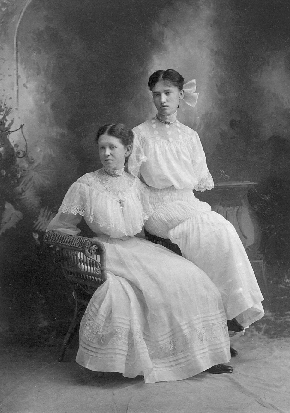 |
| Two more daughters: Veda and Hazel |
William and Edith were married civilly on September 26, 1913, perhaps to help clear up any question of the children’s legitimacy. Margaret, his fourth wife, died on November 21 that year in Portland at the age of 51. She is buried in the Logan Cemetery. William served as city doctor for a time in Logan and gave physicals to the young men drafted into World War I. A terrible influenza epidemic followed the war in 1919, killing more people than the war. Many were afflicted in Logan, and many died. Schools, theaters, dance halls, and other places where people gathered were closed. William worked night and day. Lorna says he and his son Billy, an established doctor himself now, were the best fever doctors in town. William’s daughter Alice, who was pregnant, died in the epidemic and was buried with her unborn child, leaving a small son. William’s son Ben, a medical student at the University of Utah, also died in the flu. Because of the danger they were not able to hold a funeral. William found it very hard to bury his children. Lorna says, “He worked so hard at this time, not taking care of himself, that he became an easy target for the flu and complications set in, causing his death.” William died after a 14-month illness on November 9, 1920, in Logan, at the age of 68. “His family often said that on his death certificate it should have read, ‘He died from exhaustion while trying to save others in the terrible Influenza Epidemic.’”21 “His funeral services were held in the Logan Tabernacle, and the building was filled to overflowing.” He was buried in the Logan Cemetery near Clarissa.
Of his four wives, Elizabeth and Edith survived him. Lorna, in a history of Elizabeth, says she was industrious, a good cook, that she raised a big garden, made all kinds of bread, knit stockings, and helped her children go to school. “She was a faithful member of the Church and always bore a strong testimony.” She lived with her daughters Ada, who was widowed, and Lizzie, who never married. Elizabeth developed diabetes and was blind the last six years of her life. She died two years after William, on August 10, 1922, in Logan at the age of 69 and is buried by his side. Karma describes Edith as “refined and a perfect lady. . . . She had a good philosophy and an abiding faith in the gospel of Jesus Christ. . . . She had lived polygamy and believed it was God inspired.” Edith was ill for 15 months and grew so thin and weak and dizzy she eventually had to stay in bed. Veda and the other children helped care for her. She died on February 11, 1926, in Logan, at age 58, and is buried opposite William, by Elizabeth’s side.
Notes
1. According to John Cameron’s history, Alice Cameron had the care of William when they crossed the plains, which appears to be an error. Perhaps Alice cared for him after his mother died until his father remarried.
2. It is possible that the Hodgsons left Utah out of discouragement or disillusion. Their obituaries leave out any reference to their Utah years, and Jeanine Borree, a Hodgson descendant, thinks they left when Richard was asked to live polygamy (Sonoma Democrat, 27 Jul. 1901, 4; 21 Nov. 1905, 2; Ron Wiser to Ben Parkinson [e-mail], 10 Sep. 2003). It is also possible that John Parkinson brought his family to Oregon after souring on Mormonism. It seems unusual from a modern perspective that after 12 years in the Church, John remained a priest rather than advancing to the office of elder. On the other hand, St. Louis branch records show him serving actively in that office up until the time he left for Oregon. William’s strong desire to come to Utah after his father’s death can also be taken as evidence that John remained faithful.
3. Lorna England Bingham records that William worked on the first bridge across the Columbia River, but Mary Parkinson, a daughter of William’s half-brother John T., says this is incorrect as he died before ever reaching the Columbia. Perhaps he used his carpentry skills on another bridge to earn money for the trip.
4. Unless otherwise noted, quotations from Lorna are from her history of William (see below).
5. According to Elizabeth Graham’s history, in 1864 crickets devoured the wheat crop in the town of Deseret. In 1865 the dam broke and ruined their crops a second time. In 1866 saleratus (alkali) came up on the land and ruined their crops again. Elizabeth fell ill, so her husband Alex “went to the few remaining families and asked if they could find a little white flour that some white bread might be made for his sick wife. White flour was more precious than gold at that time. Every neighbor scraped their flour bins and shook their flour sacks and gave what they had to Alex. In this way, enough flour was gathered to make one small square loaf of bread.
“A small, thin slice of this together with a larger slice of bran bread was given to Elizabeth at meal time. The one attending her would take the little children out of their Mother’s room when meal time came because she knew that their mother could not eat the white bread and see her little girls go without. But Elizabeth with tears in her eyes would eat the bran bread and hide the white bread under her pillow. Later when the children returned to her room, she would motion for them to come to her. Then she would divide the white bread between them, and not once did she taste the white bread.”
One further example of their poverty: when the Grahams received the offer to join the Grants in Oregon, Elizabeth had to fold her threadbare dish rag several times to make a patch for Alex’s trousers, using a long blade of yellow grass for thread.
6. The quote is from Utah Since Statehood (see below), which situates the mine work after his move to Morgan.
7. William and Elizabeth’s children are Lilian (19 May 1874, Morgan), Ada (31 Dec. 1875, Morgan), William Brigham Jr. (24 Dec. 1877, Morgan), Elizabeth (11 Aug. 1879, Morgan), Afton (8 Jan. 1886, Logan), and Winifred (5 Apr. 1891, Logan).
8. His obituary places this when he moved to Franklin but says he was ordained a high priest there as well, while other sources say he was made a high priest prior to becoming a bishop in Morgan.
9. William and Clarissa’s children are Albert Woffindin (8 Jan. 1877, Morgan), Clarissa Atelia (2 May 1879, Morgan), Leona (9 Aug. 1881, Morgan), George Taggart (27 Dec. 1883, Coalville), Marcus Taggart (17 Apr. 1886, Lewiston), Hazel (1 Jul. 1889, Hyde Park), and Mary Alice (25 Sep. 1891, Franklin).
10. Lorna’s history of Elizabeth says they made rugs during William’s mission, but her history of William says they lived with their fathers during the mission and places the rug-making during medical school.
11. William and Edith’s marriage is missing from the Logan temple record. William’s temple book, begun in August 1927 and kept by his daughter Lizzie Parkinson, gives their marriage as follows: “Jan 27th 1886 Sealed Logan Temple by M. W. Merrill.” According to the Logan temple record, Mariner W. Merrill (later an Apostle) was doing sealings in the temple this day; see FHL film 0178135.
12. William and Edith’s children are Fred Benson (8 Jan. 1887, Pilot Rock), Veda Benson (20 Sep. 1888, Pilot Rock), John Benson (or Jack, 11 Jul. 1890, Logan), Ezra Benson (or Ben, 27 Apr. 1893, Logan), Karma Benson (30 Sep. 1896, Logan), Wallace Benson (3 Jul. 1901, Logan), Don Benson (17 Aug. 1903, Logan), and Edith Benson (25 Jan. 1909, Logan).
13. The temple book kept by Lizzie Parkinson gives the date as 1890, but as with Edith’s marriage we haven’t been able to confirm this from contemporary records.
14. Edward L. Sloan worked for the Deseret News and the Salt Lake Daily Telegraph and was founding editor of the Salt Lake Herald, which had given Dr. Kohler such a hard time, and the Woman’s Exponent. He adapted the words of a Swiss hymn that has become a Mormon standard, “For the Strength of the Hills.”
15. Another interpretation of these events is that William and Margaret were not married before their September 1, 1892, sealing in Manti. During this early post-Manifesto period, some Church leaders, including at least two Apostles, were quietly teaching that those who could live polygamy legally (such as those living in other countries) should continue to do so. Once William divorced Elizabeth civilly, in the eyes of the law he was not married to any of his wives and so was free to take another. This would makes Clara R. Ward’s comment about her Sloan uncles’ anger difficult to understand.
16. William and Margaret’s children are Willa Sloan (24 May 1893, Logan), Louisa Sloan (15 Oct. 1894, Logan), and Venoletta Sloan (19 Jan. 1896, Logan, died 19 Sep. 1896).
17. Of Margaret’s Cosmopolitan articles, Clara says, “She wrote them under an assumed name so I have not been able to find any magazine articles that she wrote.”
18. This is a composite photo. The “Parkinson” sign is from another photo of Edith’s house and may be older or newer than the photo with William.
19. Margaret, in the divorce proceedings, accuses William of telling her she shouldn’t mind or care that he was associating with his other wives as he had learned through astrology that she would die soon. Like much else in the proceedings, this is likely exaggerated, though from Karma’s account of her siblings’ courtships, it is not difficult to imagine William being insensitive.
20. Karma writes: “This is the creed of Dr. Wm. B. Parkinson, Sr. Don’t keep your fountains of your love and tenderness sealed up until your friends are dead; fill their lives with sweetness now. Speak approving and cheering words, while their ears can hear, and while their hearts can be thrilled and made happier by them. The kind things you will say after they are gone, say them before they go. The flowers you mean to send for their coffins, bestow them now and so brighten and sweeten their earthly homes before you leave them. If my friends have sweet perfumes and sympathies and affection which they intend to bestow upon my dead body, I’d rather they’d give them to me in my troubled and weary hours. That I may be refreshed and cheered while I need them. I’d rather have a plain coffin without a flower, a funeral without a eulogy, than a life without the sweetness of love and sympathy. Let us learn to anoint our friends beforehand for their burial. Postmortem kindness does not cheer the burdened spirit. Flowers upon the coffin shed no fragrance backward over the weary way by which loved ones have traveled.”
It is interesting in light of this creed that William and his three wives buried in Logan have only humble headstones. These sank and were in danger of sodding over until Clarissa McAlister Beutler, a granddaughter, collected the money to raise the stones and set them in concrete in 2001.
21. This sentence is from Lorna England Bingham Olsen, “History of Ada Parkinson, Native Pioneer” (3 Sep. 1980).
Sources